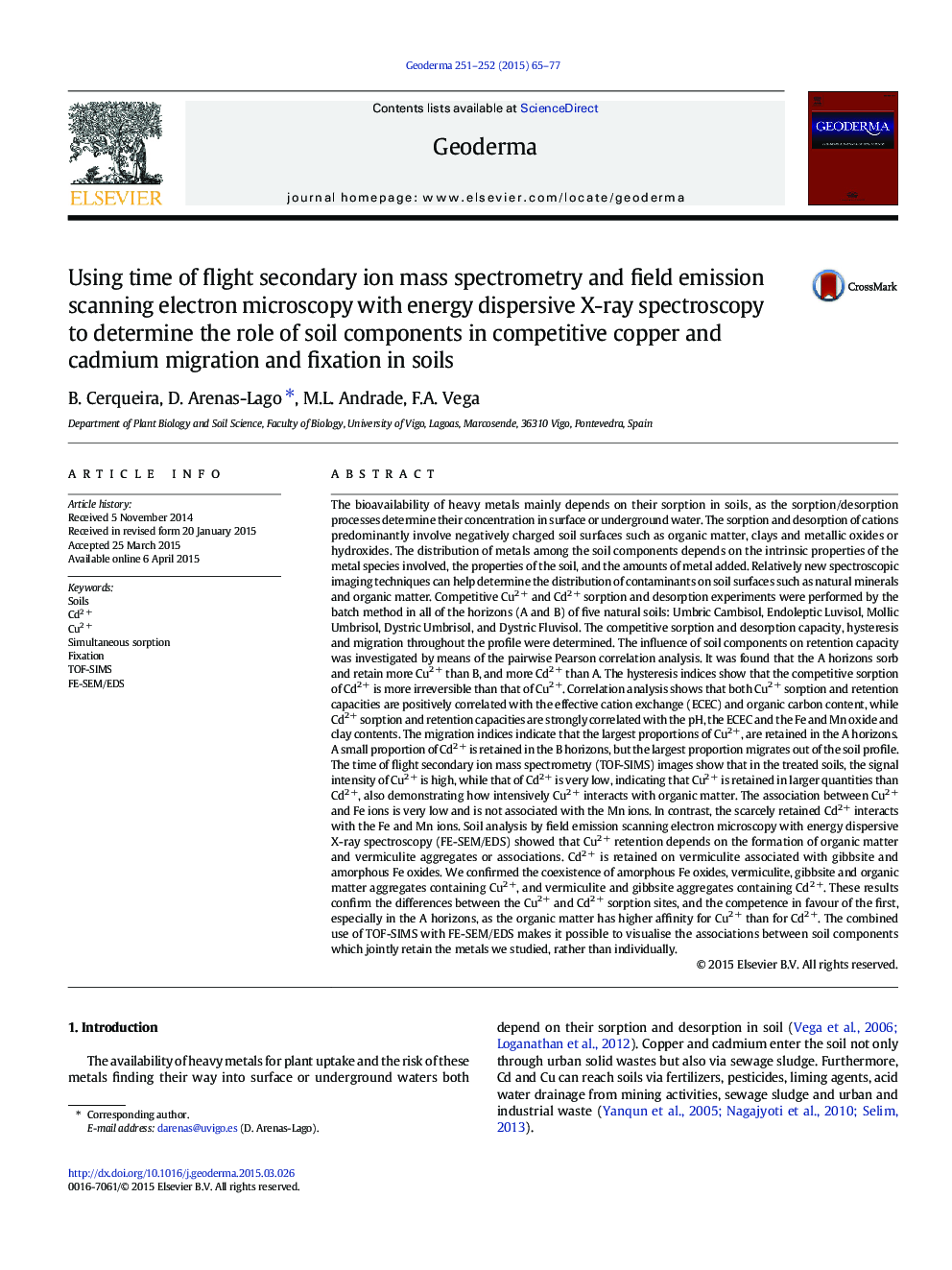| کد مقاله | کد نشریه | سال انتشار | مقاله انگلیسی | نسخه تمام متن |
|---|---|---|---|---|
| 6408555 | 1629460 | 2015 | 13 صفحه PDF | دانلود رایگان |
- Competitive sorption of Cd2Â + is more irreversible than that of Cu2Â +.
- The largest proportion of Cd2Â + migrates out of the soil profile.
- Interactions among soil components and metals were determined by TOF-SIMS & SEM/EDS.
- The associations between the soil components that retain each metal were identified.
The bioavailability of heavy metals mainly depends on their sorption in soils, as the sorption/desorption processes determine their concentration in surface or underground water. The sorption and desorption of cations predominantly involve negatively charged soil surfaces such as organic matter, clays and metallic oxides or hydroxides. The distribution of metals among the soil components depends on the intrinsic properties of the metal species involved, the properties of the soil, and the amounts of metal added. Relatively new spectroscopic imaging techniques can help determine the distribution of contaminants on soil surfaces such as natural minerals and organic matter. Competitive Cu2Â + and Cd2Â + sorption and desorption experiments were performed by the batch method in all of the horizons (A and B) of five natural soils: Umbric Cambisol, Endoleptic Luvisol, Mollic Umbrisol, Dystric Umbrisol, and Dystric Fluvisol. The competitive sorption and desorption capacity, hysteresis and migration throughout the profile were determined. The influence of soil components on retention capacity was investigated by means of the pairwise Pearson correlation analysis. It was found that the A horizons sorb and retain more Cu2Â + than B, and more Cd2Â + than A. The hysteresis indices show that the competitive sorption of Cd2Â + is more irreversible than that of Cu2Â +. Correlation analysis shows that both Cu2Â + sorption and retention capacities are positively correlated with the effective cation exchange (ECEC) and organic carbon content, while Cd2Â + sorption and retention capacities are strongly correlated with the pH, the ECEC and the Fe and Mn oxide and clay contents. The migration indices indicate that the largest proportions of Cu2Â +, are retained in the A horizons. A small proportion of Cd2Â + is retained in the B horizons, but the largest proportion migrates out of the soil profile. The time of flight secondary ion mass spectrometry (TOF-SIMS) images show that in the treated soils, the signal intensity of Cu2Â + is high, while that of Cd2Â + is very low, indicating that Cu2Â + is retained in larger quantities than Cd2Â +, also demonstrating how intensively Cu2Â + interacts with organic matter. The association between Cu2Â + and Fe ions is very low and is not associated with the Mn ions. In contrast, the scarcely retained Cd2Â + interacts with the Fe and Mn ions. Soil analysis by field emission scanning electron microscopy with energy dispersive X-ray spectroscopy (FE-SEM/EDS) showed that Cu2Â + retention depends on the formation of organic matter and vermiculite aggregates or associations. Cd2Â + is retained on vermiculite associated with gibbsite and amorphous Fe oxides. We confirmed the coexistence of amorphous Fe oxides, vermiculite, gibbsite and organic matter aggregates containing Cu2Â +, and vermiculite and gibbsite aggregates containing Cd2Â +. These results confirm the differences between the Cu2Â + and Cd2Â + sorption sites, and the competence in favour of the first, especially in the A horizons, as the organic matter has higher affinity for Cu2Â + than for Cd2Â +. The combined use of TOF-SIMS with FE-SEM/EDS makes it possible to visualise the associations between soil components which jointly retain the metals we studied, rather than individually.
Journal: Geoderma - Volumes 251â252, August 2015, Pages 65-77
